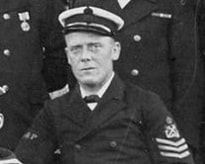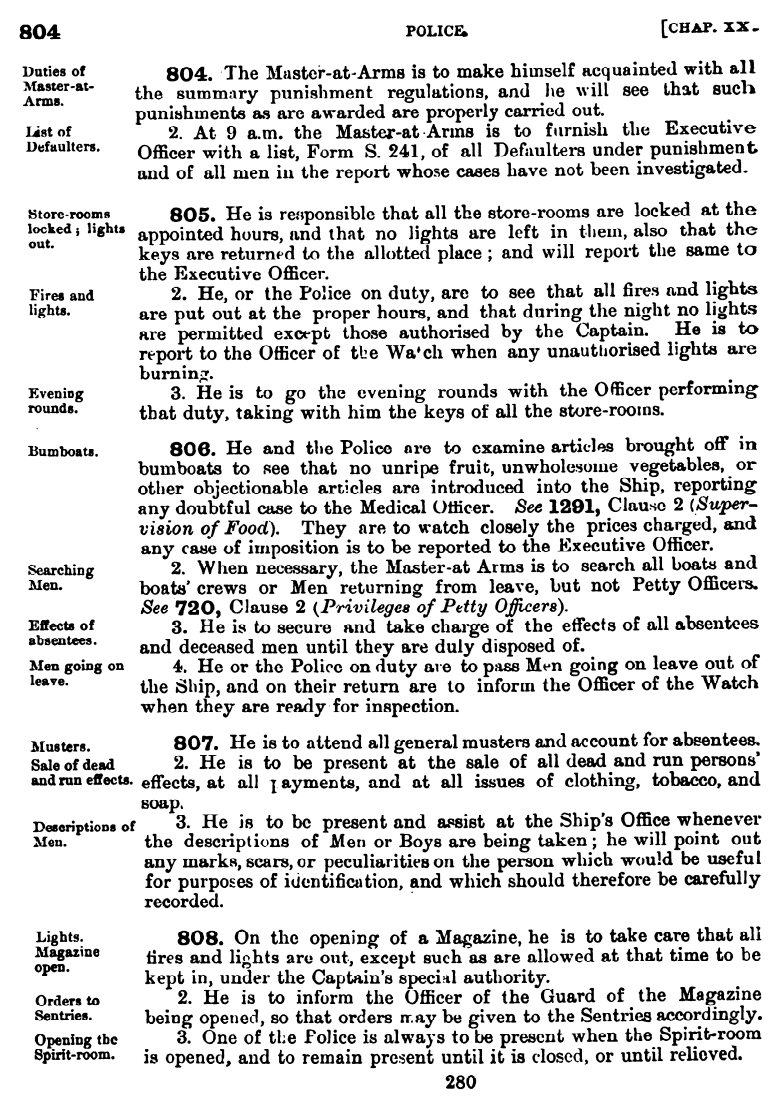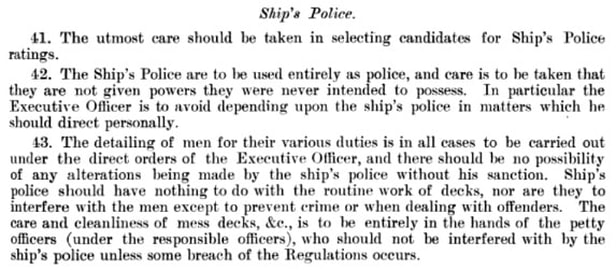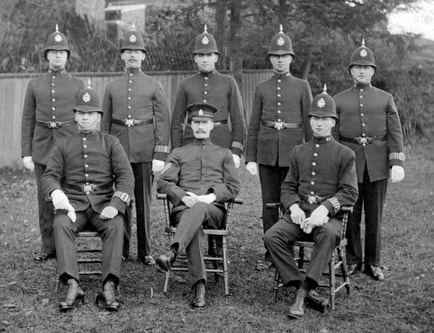Looking Back: Ship’s Police in the early RCN
By Lieutenant-Colonel Paul Thobo-Carlsen (Retired), CMPA Director of History & Heritage.
The Naval Service of Canada was created on 4 May 1910, and less than one year later was renamed the Royal Canadian Navy (RCN). The enabling legislation, the Naval Service Act, bound Canada's new navy to the same Naval Discipline Act and King's Regulations and Admiralty Instructions (KR&AIs) then used by Britain's Royal Navy (RN). For this reason, the first naval policing organization in Canada was based entirely upon the RN's "Ship's Police" system. This article will shed some light on this little-known naval policing entity which operated throughout most the RCN’s first decade of existence.
|
The RN had a long-established naval presence in pre-confederation Canada where it operated primarily off the Atlantic coast from its large dockyard at Halifax, Nova Scotia. In 1865 the RN also established a Pacific coast naval station at Esquimalt, British Columbia. Several years before that, in 1861, the RN’s Ship’s Police organization had been formalized for the first time in the Queen's Regulations and Admiralty Instructions.[1] As such, RN police personnel were operating in Canada prior to confederation and they continued to do so until the RN handed over full control of its east and west coast naval stations to the fledgling Canadian navy in 1910.
The Ship's Police organization for each major warship was headed by a "Master-at-Arms" of either Chief Petty Officer or Warrant Officer rank who was assisted by "Ship's Corporals" of Petty Officer rank. Ship's Police personnel were also employed at certain shore-based units to help ensure discipline. Sometimes other sailors were attached temporarily for police or patrol duties. In navy jargon, the Master-at-Arms was known as the "jaunty" (a corruption of the French gendarme) and the Ship's Corporals were called "crushers."[2]
|
In the case of the RN, non-commissioned officers from the Royal Marine Light Infantry (RMLI) with at lease 3 years of sea service could also become Ship's Corporals or be promoted to Master-at-Arms posts. This of course did not apply within the RCN as Canada had no equivalent force of marines.
The Canadian government arranged for the purchase of two ex-Royal Navy cruisers to form the nucleus of the country's nascent navy. HMCS Rainbow, an Apollo-class light cruiser with a compliment of 273 personnel was sent to Esquimalt on the west coast and HMCS Niobe, a much larger Diadem-class cruiser with a compliment of 705 personnel, was sent to Halifax on the east coast. These warships sailed to Canada with RN crews, and many British personnel subsequently joined the RCN to help man these vessels during the early years. Indeed, a number of ex-RN and ex-RMLI Ship's Corporals and Masters-at-Arms joined the RCN to become the core of Canada's own naval policing organization. Over time, sailors recruited in Canada began filling Ship's Police positions to supplement, and eventually replace, these British veterans.
|
|
In June 1910 the initial police staff for HMCS Niobe was set at one Master-at-Arms and five Ship's Corporals. For HMCS Rainbow it was one Master-at-Arms and two Ship's Corporals.[4] Navy documentation from October 1911 shows that HMCS Niobe's Master-at-Arms and four of its Ship's Corporal positions for were filled by ex-RN pensioners serving with the RCN on 3-year contracts. Its remaining Ship's Corporal post was filled by a non-pensioned ex-RN sailor with between 5 and 7 years of previous service.[5] For HMCS Rainbow, another document from October 1911 shows that her three Ship's Police were all imperial pensioners serving in the RCN on 3-year contracts.[6]
Canada's entry into the First World War in August 1914 necessitated the accelerated growth of the RCN and, by extension, it's police branch. This included the expanded use of Ship's Police staff to assist in maintaining discipline at shore establishments as well as on its larger ships. For example, in March 1918, the shore establishment for HMCS Landsdown at Sydney, Nova Scotia included one Master-at-Arms and one Ship's Corporal.[7] By late 1915, HMCS Niobe—as a result of previously sustained damage and her overall obsolescence—was converted to a docked "depot ship" (headquarters and dormitory) at the Halifax naval yard. Niobe's police staff expanded and took on some new roles in support of its depot ship status. As of February 1918, Niobe's compliment was proposed to include: [8]
POLICE STAFF
1 M.A.A. for general discipline duties. 1 M.A.A. for victualling duties. 1 M.A.A. for duty with Imperial drafts. 1 M.A.A. for regulating duties. 4 Sh. Cpls. for general discipline duties. 1 Sh. Cpl. for victualling duties. 1 Sh. Cpl. prisoners and cell punishment. 1 Sh. Cpl. as mail corporal. 1 Sh. Cpl. for regulating duties. |
As the war progressed a number of senior Ship's Police personnel were promoted to Warrant rank and given the title "Chief Master-at-Arms." By 1918, these included: [9]
- Ch. M.A.A. Hubert John Carpenter (HMCS Niobe, drafting duties and charge of Ship's Police),
- Ch. M.A.A. John Thomas Gammon, MBE (HMCS Niobe),
- Ch. M.A.A. John Sixsmith (HMCS Niobe, barrackmaster), and
- Ch. M.A.A. William R, Hadley (HMCS Rainbow, shore establishment).
|
Chief Master-at-Arms John Gammon was the only non-commissioned member of the RCN to be appointed as a Member of the Most Excellent Order of the British Empire (MBE) during the First World War. Gammon was born in the United Kingdom and had served in the Royal Navy for six years year before transferring to the RCN in August 1910 where he was initially employed as a Leading Stoker on HMCS Niobe. He qualified as a diver the next year and then became a Ship's Corporal in January 1912. Gammon was promoted into a Master-at-Arms position at HMCS Niobe in September 1915 and promoted again in April 1917 to become the ship's Chief Master-at-Arms. Throughout this time he retained his dive qualification, and at one point in February 1916 was detailed as a diving instructor.[10] At the time of the fateful 'Halifax Explosion' on 6 December 1917 (when the Norwegian ship SS Imo struck the French cargo ship SS Mont-Blanc and ignited her cargo of high explosives), Ch MAA Gammon was overseeing a dive operation off the Halifax dockyard pier. The explosion killed five sailors on the wharf who had been supporting two submerged divers. The subsequent actions of Gammon and one other surviving sailor enabled these two divers to be safely brought to the surface. For his gallantry and devotion to duty Ch MAA Gammon was awarded the MBE.
|
In July 1918 new RCN pay rates were published which included the provision for promotion to a new rank of "Commissioned Master-at-Arms" (equivalent to Sub-Lieutenant). However, no evidence has been found to show that any RCN personnel were promoted to this rank under the Ship's Police system. Notwithstanding, this rank would later be held by some members the RCN Regulating Branch during the Second World War.
When the Canadian Naval Service was first created in 1910, its Ship's Police were initially governed by the 1906 edition of the KR&AIs.[11] The chapter on police duties is shown below in its entirely. The KR&AIs were further updated in 1913 and that version was in effect throughout the First World War and until the Ship's Police system was replaced by the Regulating Branch in 1919.[12].
In general, the Ship's Police were charged with the maintenance of order and discipline amongst the men and ensuring the observance of standing orders. This included the prevention of disorderly conduct, the detection of crime (i.e., offences against the Naval Discipline Act), maintaining the defaulters book, conducting searches for contraband or stolen items, taking charge of all prisoners, and overseeing that lawfully imposed punishments were properly carried out. In addition, the Ship's Police were tasked to carry out a number of military duties that were not strictly of a policing nature. This included ensuring that all lights and fires were extinguished at the proper hours, being present whenever rum or other spirits were being dispensed, ensuring storerooms were secured when not in use. and holding auctions to dispose of the property of sailors who died or had deserted. A scan of period newspapers and literature also shows that ship's Masters-at-Arms would sometimes be asked to take over custody of sailors who had been arrested by the civilian police for relatively minor offences or disturbances of the peace.
Below is an excerpt from an Admiralty Circular sent in September 1912, which sheds some additional light on the employment of Ship's Police ratings. In its early years the RCN relied heavily on regulations and instruction drafted for the Royal Navy, so it is very likely that the points in this circular were applied equally in the RCN as they were in the RN: [13]
By the end of the First World War, the Ship's Police system had came under increased scrutiny within the Royal Navy. This system, to some degree, was a product of an earlier era when mutinies were common and sailors were often young and poorly educated and prone to getting into trouble when idle. Some in the RN felt the Divisional System (which still exists today in the CAF/RCN) was an adequate vehicle for ensuring naval discipline. In November 1918 Admiralty Fleet Order 3689 called upon senior naval commanders to provide their opinions on the continuing need for the Ship's Police branch. The results from this survey showed that the majority of respondents believed there was still a role for specialist personnel to assist in the maintenance of discipline and that experienced Masters-at-Arms provided important support to commanders. However, some commanders argued that reform was needed to ensure the Ship's Police did not undermine the authority of regular Petty Officers in carrying out their disciplinary responsibilities under the Divisional System. In the end, a compromise solution was stuck. Admiralty Fleet Order 2290 of 2 July 1919 abolished the Ship’s Police branch and replaced it with the Regulating Branch—consisting of Masters-at-Arms and Regulating Petty Officers.[14]
No documents have been found to ascertain the points of view of senior RCN commanders on the Ship's Police system, but in any event Canada quickly decided to follow the Royal Navy's lead. Although the exact date when the Ship's Police organization was formally replaced by the Regulating Branch in Canada is unclear, we do know that when new RCN pay rates (per diems) were approved on 20 May 1920 the Regulating Branch was included as follows: [15]
The first members of the RCN's Regulating Branch were its former Ship's Police. While the word "police" was removed from the branch name, these new "regulators" continued to conduct a number of police-type tasks in support of navy commanders. The Regulating Branch would remain part of the regular RCN until 1960, when general regulating duties were taken over by Boatswains and the duties formerly performed by Masters-at-Arms were assumed by ship's Coxswains. The naval reserve, however, retained separate Regulating Branch ratings until the unification of the Canadian Armed Forces on 1 February 1968.
The RCN Ship's Police organization forms an important element in the historical lineage of Canada's present day military police. Because this body pre-dated the First World War and since its members were specifically "rated" as tradesmen for these specialist duties, they were arguably Canada's first permanent service police organization.
"Ship's Police" or "Naval Police"?
Some online and secondary printed sources refer to the police of the RN and RCN during this period as "Naval Police" rather than as "Ship's Police." In the RN context, there is perhaps some validly to this given that certain Admiralty documents from the mid-1860s until the early 1900's did sometimes use terminology such as "Naval Police" and "Naval Police Force." However, some of these also used both "Ship's Police" and "Naval Police" in the same document—essentially interchangeably.
In the Canadian context, the author has found no official RCN documents from the 1910-1919 period that refer to the RCN's police specialists as "Naval Police." Examples can be found in period Canadian newspapers where "naval police" (lower case) is used to describe the RCN's Masters-at-Arms and Ship's Corporals. However, this term was likely used by journalists in a colloquial fashion to easily explain the role of these sailors to laypersons. It may also have been written this way as an assumption based on the "NP" badges worn by police personnel in the navy.
To add further confusion, both the United Kingdom and Canada employed civilian police forces at their major naval dockyards to provide access control, security and some general policing services. In Canada, the Dominion Police operated dockyard police detachments at both Halifax and Esquimalt from 1910 to 1919. Many period newspaper articles referred to these civilian policemen as "Naval Police" even though they were not actually members of the RCN.
It is instructive to note that the Queens Regulations and Admiralty Instructions of 1861 and 1879 used only the terms "Ship's Police" or "Police" alone when describing the duties of the Masters-at-Arms and Ship's Corporals. Similarly, the King's Regulations and Admiralty Instructions of 1906 and 1913 make no reference to "Naval Police" and also use only "Ship's Police or "Police" alone to describe these personnel. Finally, in the Canadian context, records of the Parliamentary debates from 1910 pertaining to pay rates for new Canadian Naval Service refer to members of this rating as "Ship's police."[17] Therefore, Ship's Police seems the appropriate name for this organization as it existed in Canada from 1910 to 1919.
------------
Notes:
1. Chapter XIII "Police" in: United Kingdom, The Queen's Regulations and the Admiralty Instructions for the Governance of Her Majesties Naval Service (London: Her Majesty's' Stationary Office, 1862), pp. 129-130. While this bound volume was printed in 1862, these QR&AIs were approved by Order in Council and came into effect on 6 August 1861. Although the "Ship's Police" terminology first emerged in this publication, the Royal Navy's use of Masters-at-Arms to enforce discipline dates back to 1699 and the use of Ship's Corporals in this role goes back even earlier.
2. The later term was also use to describe civilian policemen in the United Kingdom and Australia beginning around 1835. See "Crusher" in Green’s Dictionary of Slang online at: greensdictofslang.com/entry/nraaffq.
3. The MAA in this photo is very likely John Sixsmith who is known from service records to have served as HMCS Rainbow's MMA from 26 Jul 1910 to 8 May 1917. He was subsequently transferred to Halifax and served at the RCN barracks upon promotion to Ch MAA. Sixsmith died from natural causes in Esquimalt on 30 September 1920 and is listed in the Military Police Memorial Roll online (www.cmpa-apmc.org/memorial-roll.html). The identity of the Ship's Corporal is less clear. The only two men known from service records to have been employed as Ship's Corporal's on HMCS Rainbow in 1910 were John Milne and Frederick G. Blake. Both of them were ex-RMLI pensioners.
4. Library and Archives Canada (LAC), RG 24-D-1, Vol 5585, file 1-1-22, Memo from RAdm to CO HMS Niobe regarding ship's compliments, 25 June 1910.
5. LAC, RG 24-D-1, Vol 5585, file 1-1-22, CO HMCS Niobe to Secretary of Dept. of Naval Service, 23 October 1911.
6. LAC, RG 24-D-1, Vol 5585, file 1-1-22, Return of Ranks and Ratings as of 15 Oct 1911 for HMCS Rainbow, 23 October 1911.
7. LAC, RG 24-D-1, Vol 5585, file 1-1-22, Memo to Captain in Charge at Sydney NS, 26th March 1918.
8. LAC, RG 24-D-1, Vol 5585, file 1-1-22, CO HMCS Niobe to Admiral Superintendent HMC Dockyard, Halifax, 18 February 1918. Note: victualling duties pertain to the provisioning of food and other stores.
9. Canada, Department of the Naval Service, The Canadian Naval List for March 1918 (Ottawa: Government Printing Bureau, 1918), The Canadian Naval List for October 1918 (Ottawa: Government Printing Bureau, 1918), and LAC, RG 24, accession 1992-93/169 GAD, box 35, file 47-23-C-372, personnel file for Ch MAA Hubert J. Carpenter. Warrant rank in the navy was a bridge between the Chief Petty Officer rating and commissioned rank. They wore officer-style uniforms but held a warrant of appointment rather than a sovereign's commission.
10. LAC, RG 150, Accession 1992-93/170, Vol 6. RCN service ledger sheet for John Thomas Gammon.
11. United Kingdom, The King's Regulations and the Admiralty Instructions for the Governance of Her Majesties Naval Service, 1906 (London: Her Majesty's' Stationary Office, 1906), pp. 279-281. Online at babel.hathitrust.org/cgi/pt?id=nyp.33433009332473&view=1up&seq=5.
12. United Kingdom, The King's Regulations and the Admiralty Instructions for the Governance of Her Majesties Naval Service, 1913 (London: Her Majesty's' Stationary Office, 1913), pp. 270-272. Online at archive.org/details/kingsregulations01greaiala/page/270/mode/2up.
13. "Enclosure to Circular Letter No. 32 of the 7th September 1912", reprinted in Statement of the First Lord of the Admiralty Eplanatory of the Navy Estimates, 1913-1914 (London: His Majesty's Stationary Office, 1914) p. 27.
14. "Branch History," Regulating Branch and Royal Navy Police Association. Online at rba93.com/our-heritage/branch-history-policing/.
15. The Canada Gazette, No. 5, Vol LIV, Saturday 31 July 1920, p. 350.
16. This may be CPO Edward S. Chappell. He was an ex-RN pensioner who came to the RCN, as plumber, in 1910 on a 3-year contract. Chappelle was employed as a plumber until 18 July 1917 at which point his service record indicates that he was "To be rated Act. C.P.O. RCNVR for Police duties." On 1 Apr 1918 he was re-rated as a Master-at-Arms. LAC, RG 150, accession 1992-93/170, Volumes 11 and 18, RCN service ledger sheets for Edward S. Chappell.
17. Canada, Official Report of the Debates of the House of Commons of the Dominion of Canada, Second Session—Eleventh Parliament, Vol XCVII (Ottawa: King's Printer, 1910), p. 85.
18. As reprinted in: United Kingdom, The Navy List corrected to 20th June 1877 (London: Her Majesty's' Stationary Office, 1877), p. 449.
Notes:
1. Chapter XIII "Police" in: United Kingdom, The Queen's Regulations and the Admiralty Instructions for the Governance of Her Majesties Naval Service (London: Her Majesty's' Stationary Office, 1862), pp. 129-130. While this bound volume was printed in 1862, these QR&AIs were approved by Order in Council and came into effect on 6 August 1861. Although the "Ship's Police" terminology first emerged in this publication, the Royal Navy's use of Masters-at-Arms to enforce discipline dates back to 1699 and the use of Ship's Corporals in this role goes back even earlier.
2. The later term was also use to describe civilian policemen in the United Kingdom and Australia beginning around 1835. See "Crusher" in Green’s Dictionary of Slang online at: greensdictofslang.com/entry/nraaffq.
3. The MAA in this photo is very likely John Sixsmith who is known from service records to have served as HMCS Rainbow's MMA from 26 Jul 1910 to 8 May 1917. He was subsequently transferred to Halifax and served at the RCN barracks upon promotion to Ch MAA. Sixsmith died from natural causes in Esquimalt on 30 September 1920 and is listed in the Military Police Memorial Roll online (www.cmpa-apmc.org/memorial-roll.html). The identity of the Ship's Corporal is less clear. The only two men known from service records to have been employed as Ship's Corporal's on HMCS Rainbow in 1910 were John Milne and Frederick G. Blake. Both of them were ex-RMLI pensioners.
4. Library and Archives Canada (LAC), RG 24-D-1, Vol 5585, file 1-1-22, Memo from RAdm to CO HMS Niobe regarding ship's compliments, 25 June 1910.
5. LAC, RG 24-D-1, Vol 5585, file 1-1-22, CO HMCS Niobe to Secretary of Dept. of Naval Service, 23 October 1911.
6. LAC, RG 24-D-1, Vol 5585, file 1-1-22, Return of Ranks and Ratings as of 15 Oct 1911 for HMCS Rainbow, 23 October 1911.
7. LAC, RG 24-D-1, Vol 5585, file 1-1-22, Memo to Captain in Charge at Sydney NS, 26th March 1918.
8. LAC, RG 24-D-1, Vol 5585, file 1-1-22, CO HMCS Niobe to Admiral Superintendent HMC Dockyard, Halifax, 18 February 1918. Note: victualling duties pertain to the provisioning of food and other stores.
9. Canada, Department of the Naval Service, The Canadian Naval List for March 1918 (Ottawa: Government Printing Bureau, 1918), The Canadian Naval List for October 1918 (Ottawa: Government Printing Bureau, 1918), and LAC, RG 24, accession 1992-93/169 GAD, box 35, file 47-23-C-372, personnel file for Ch MAA Hubert J. Carpenter. Warrant rank in the navy was a bridge between the Chief Petty Officer rating and commissioned rank. They wore officer-style uniforms but held a warrant of appointment rather than a sovereign's commission.
10. LAC, RG 150, Accession 1992-93/170, Vol 6. RCN service ledger sheet for John Thomas Gammon.
11. United Kingdom, The King's Regulations and the Admiralty Instructions for the Governance of Her Majesties Naval Service, 1906 (London: Her Majesty's' Stationary Office, 1906), pp. 279-281. Online at babel.hathitrust.org/cgi/pt?id=nyp.33433009332473&view=1up&seq=5.
12. United Kingdom, The King's Regulations and the Admiralty Instructions for the Governance of Her Majesties Naval Service, 1913 (London: Her Majesty's' Stationary Office, 1913), pp. 270-272. Online at archive.org/details/kingsregulations01greaiala/page/270/mode/2up.
13. "Enclosure to Circular Letter No. 32 of the 7th September 1912", reprinted in Statement of the First Lord of the Admiralty Eplanatory of the Navy Estimates, 1913-1914 (London: His Majesty's Stationary Office, 1914) p. 27.
14. "Branch History," Regulating Branch and Royal Navy Police Association. Online at rba93.com/our-heritage/branch-history-policing/.
15. The Canada Gazette, No. 5, Vol LIV, Saturday 31 July 1920, p. 350.
16. This may be CPO Edward S. Chappell. He was an ex-RN pensioner who came to the RCN, as plumber, in 1910 on a 3-year contract. Chappelle was employed as a plumber until 18 July 1917 at which point his service record indicates that he was "To be rated Act. C.P.O. RCNVR for Police duties." On 1 Apr 1918 he was re-rated as a Master-at-Arms. LAC, RG 150, accession 1992-93/170, Volumes 11 and 18, RCN service ledger sheets for Edward S. Chappell.
17. Canada, Official Report of the Debates of the House of Commons of the Dominion of Canada, Second Session—Eleventh Parliament, Vol XCVII (Ottawa: King's Printer, 1910), p. 85.
18. As reprinted in: United Kingdom, The Navy List corrected to 20th June 1877 (London: Her Majesty's' Stationary Office, 1877), p. 449.

















